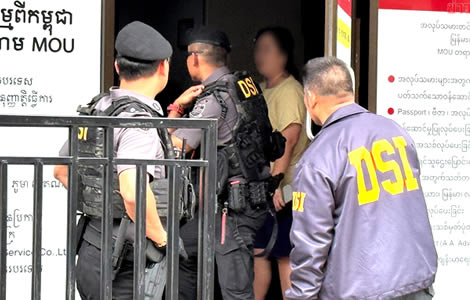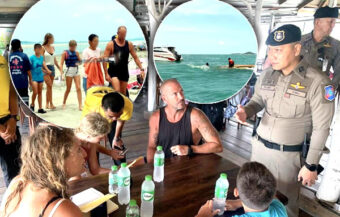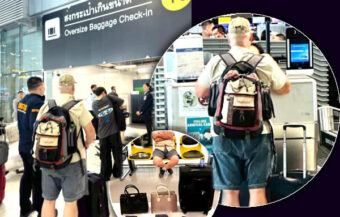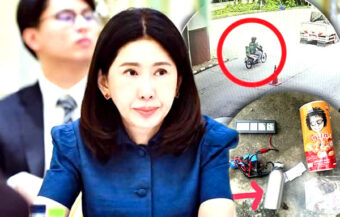A rising number of accidents on Thai building sites involving construction cranes, particularly in Bangkok where there is an ongoing condominium constriction boom, has prompted a leading Thai engineering body to call for legislation and regulation of the installation and use of cranes on building sites. It comes after last week’s appalling accident which saw 5 construction site workers killed and 5 more injured on a construction site near Lumpini in Bangkok. The site was closed and building work suspended for 30 days as Thai police undertook a rigorous investigation into possible negligence in relation to the tragedy.
Thailand’s Council of Engineers this week has called for a mandatory process that would require building sites to seek approval for the erection of construction cranes. It comes after a deadly accident at Bangkok’s Rama III road which saw 5 construction workers lose their lives. The Secretary General of the council, Mr Amorn Pimanmas, pointed out this week that no such permission is currently required.
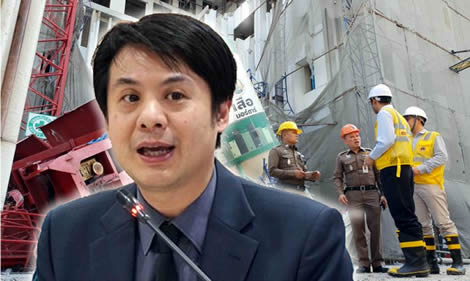
The tragic accident last week took place at the site of the new Riverine Condominium development near Lumpini park, a fashionable and much sought after area in Bangkok. It occurred when the boom of a construction crane fell off and came crashing to the ground. Workers are reported to have been attempting to amend its situation to reach a higher point in the construction project.
Royal Thai Police investigating the accident on the basis of possible fatal negligence
The tragedy drew an immediate response from the Royal Thai police from Bang Phong Phang police station where Colonel Somport Suwanjarat was reported last week to be urgently seeking out the engineers responsible for the project. The police officer made it clear that there could be charges of fatal negligence as a result of the accident. Of course, this will be subject to a full police investigation. The accident occurred on the afternoon of Wednesday the 23rd January. The initial crash left the crane badly damaged and one worker trapped high above the wreckage. The worker was reported to have suffered a broken leg and heavy loss of blood. Four construction workers had already been confirmed as dead in the immediate aftermath of the crash as a rescue effort was launched. Although the man was successfully brought down and transferred to hospital, he died a short time later reportedly from excessive loss of blood bringing the total number killed to five. A further five were reported to be injured.
It is understood that Thai police are now consulting with engineering professionals, familiar with such projects, to determine the cause of the accident and whether there is a case for negligence. The police were also seeking cooperation from the company behind the condominium project.
Use and installation of site cranes may be a site safety blind spot in Thailand’s busy construction sector
The continued pace of development in Bangkok, where condominiums have emerged both as a convenient way to live and as good investment, means that Thailand’s capital city has had more and more construction cranes on its skylines now for well over decade. This is not a property boom or bubble but a controlled industry where costs and margins are key but also where, for many years, there has been an open commitment to site safety. However, the installation and use of site cranes now appears to be a very dangerous blind spot that requires urgent action to prevent further loss of life.
Civil engineer believes faulty installation of the site crane or age and condition may have been key factors in the fatal accident
One civil engineer, who is reported to be working on the investigation, told the Bangkok Post newspaper that an improper installation of the crane at the site may have been the cause of the accident. This has yet to be confirmed. Chulert Jitjurjun said that he believed that the crane being used was old and may already have had significant wear and tear which impaired its safety.
Engineering council in Thailand warns members of permanent suspension if found to be negligent
There is concern in Bangkok at the number of accidents on building sites in recent years involving construction cranes. The call by Thailand’s Council of Engineers simply reflects this. There is a feeling that there is a need for more effective regulation to ensure the safety of workers. The country’s council of engineers has made it clear this week that it will withdraw the licences in respect of any of its members found to be culpable or negligent in relation to this latest tragedy and the death of the five men. These suspensions will also, it is reported, be permanent. It is believed that the collapse itself did little damage to the building structure which was under construction. The capability, in recent decades, of Thailand’s engineering and construction sector to erect modern and quality buildings at impressive speed is notable often with building sites in operation 24 hours a day.
Site closed and construction halted for 30 days
Meanwhile, the police officer leading the investigation into the Rama III road construction site crash was reported last week as being unclear if properly accredited engineers were on site when the crane was being moved last week when the fatal accident occurred. Colonel Suwanjara said that this fact was an unknown at that point. City administrators for the Yan Wawa district of Bangkok, in which the site is located, moved quickly to order the site closed and construction work halted for thirty days.
Spate of crane crashes and loss of life is a wake up call and underlines need for regulation
The number of such accidents, in recent times, has caused growing alarm although this latest tragedy has seen the greatest loss of life and injury. As recently as January 11th, another crane collapsed but this time in Thailand’s Nakhon Ratchasima province, 259 km to the north east of Bangkok in the Isaan region of Thailand. There, a crane collapse killed the driver as he was attempting to lift thirty tonnes or rock. There were also two crane crashes in Bangkok last year. On September 14th, people were lucky to escape injury when a crane completely collapsed onto nearby power cables and a shop building destroying three cars and two motorbikes. The incident occurred in the Bang Rak area of Bangkok near Soi Sala Daeng 2. Only two weeks before, a construction site worker was not so fortunate and lost his life when another crane collapsed at another condominium project, this time on Rama 9 road. In April the previous year (2017), another crane collapsed, this time in the Don Mueang area of Bangkok. This occurred at a new rail line project. Three more workers at that site were killed. Thailand’s engineering leadership is rightly concerned.
Thailand’s engineering chiefs have been looking at crane safety for some time as the incidents mount
For some time, concerned engineering professionals have been looking into the reports of crane collapses and considering how best to prevent such incidents. In the last year alone, there have been already five crane collapses on Thai building sites. One of the key outcomes of such studies has been to identify the imperative of having trained engineers onsite and supervising the installation and subsequent re installation of cranes as they need to be relocated in line with the progress of each project. There is also a suggestion that engineers should be involved in supervising the use of construction cranes on building sites.
Use of site cranes must also be supervised
It is estimated, from the studies conducted by the engineering body, that up 90% of such accidents are caused by a mistake in the installation process or alternatively by putting the cranes to use in the wrong way. This might require that the operation of cranes should be directly under the supervision of qualified engineers. Some of the potential dangers cited by Thai engineering experts include the overloading of cranes and slings to hoist materials that are improperly formed. These observations were made the Amorn Pimanmas, the Secretary General of Thailand’s Council of Engineers, at a briefing to the media in Bangkok this week. Mr Pimanmas is a well known expert and campaigner in Thailand for improved engineering safety.
Calls for legislation and amendment to Thailand’s 1992 Building Act to regulate site cranes
A key observation of Thailand’s Engineering Council is the lack of legislation and oversight when it comes to the installation of cranes on construction sites. This has brought about a situation where no government officials are required to approve or authorize these installations at this time. The council has recommended an alteration or amendment to Thailand’s 1992 Building Act. This suggested regulation would require site developers and builders to seek approval for the installation of construction cranes on any building site prior to doing so. The council has made its position on this clear by sending copies of its recommendation to governing bodies such as Thailand’s Interior Ministry and Bangkok’s Metropolitan authorities.

